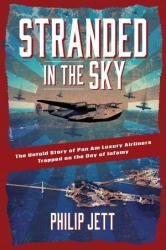 Название: Stranded in the Sky: The Untold Story of Pan Am Luxury Airliners Trapped on the Day of Infamy
Название: Stranded in the Sky: The Untold Story of Pan Am Luxury Airliners Trapped on the Day of InfamyАвтор: Philip Jett
Издательство: Turner Publishing
Год: 2023
Страниц: 416
Язык: английский
Формат: epub
Размер: 10.1 MB
From the author of Taking Mr. Exxon and The Death of an Heir comes the untold story of four luxury airliners trapped in the Pacific Ocean on and after the Day of Infamy.
In the first week of December 1941, four Pan American Airways System (Pan Am) flying clippers—the largest and most lavish transpacific airliners in the world—took off from the North American West Coast, loaded with wealthy and affluent passengers on their way to exotic destinations.
On December 7, 1941, the Imperial Japanese Navy Air Service executed a surprise coordinated attack against the US naval base at Pearl Harbor. Within hours, Midway Atoll, Wake Island, Guam, and Manila—all of which were refueling stops for these Pan Am flying clippers—were targeted and bombed by the same Japanese forces that had devastated Pearl Harbor.
The Imperial Japanese Navy task force had sailed 3,500 miles eastward from Japan across a rough and treacherous North Pacific Ocean. After twelve days and nights, the Japanese armada reached their destination in total secrecy on the morning of Sunday, December 7, 1941. From a point 230 miles directly north of Oahu in the Hawaiian Islands, at 6:00 a.m., 183 Japanese bombers and fighter planes took off from the task force’s aircraft carriers to the cheers of “banzai (hurrah)!” The first wave of attackers sped toward their target: the US Pacific Fleet moored in Pearl Harbor near Honolulu, along with nearby US Army Air Forces bases. A second wave of 167 attack planes would follow not far behind.
At 7:49 a.m., still undetected as enemy aircraft, the massive formation of Japanese planes passed over Waimea Bay on the northern tip of Oahu, zigzagging between mountains and roaring over the heads of laborers toiling in pineapple fields. The formations quickly split to follow their assigned routes that would lead them to US airfields and to Pearl Harbor. During the final minutes, crew members checked their machine guns and bombsights. Some would be releasing torpedoes, others dropping high-altitude bombs, while others would dive at their targets and release their bombs at close range. Just as the Japanese fighters and bombers neared their targets, Cmdr. Mitsuo Fuchida, who was in command of all the attacking planes, shouted the coded signal over the radio that indicated complete surprise had been achieved: “Tora! Tora! Tora!”
Of the seventy-five thousand soldiers, sailors, and Marines stationed at Pearl Harbor, Sunday morning found many aboard their ships nursing hangovers from Saturday night’s liberty. Of those awake, some prepared for Sunday worship aboard their ships, while other young men planned to meet girls on Waikiki Beach. Then suddenly from the sky without warning, just as the ships’ bugles commenced sounding eight o’clock Colors, Japanese warplanes led by Cmdr. Fuchida commenced their relentless and deadly attacks. “Like a hurricane out of nowhere, my torpedo planes, dive bombers, and fighters struck suddenly with indescribable fury,” Fuchida recalled.
Though Pearl Harbor was the top prize of the Japanese air and naval assault, the Empire of Japan executed a coordinated attack that December 7 (December 8 across the International Date Line) against other specified targets in the Pacific: Midway Atoll, Wake Island, Guam, the Philippines, Singapore, Hong Kong, Malaya (later to become part of the new nation of Malaysia), Borneo, and Thailand, many of which housed Pan Am marine bases for its transpacific clippers.
Stranded within the vast boundaries of the Pacific Ocean, these civilian airlines were unexpectedly at risk of being captured or shot down by Japanese military. The assault on Pearl Harbor removed any possibility for US military assistance, and the attack of the refueling stations made it impossible for these airlines to refuel their depleting gas tanks. Alone and unreachable, Pan Am crews and their frightened passengers were left with no choice but to make their own way across the volatile Pacific Ocean, where neither land, air, nor sea could promise safety, and do their best to survive—if they could.
Скачать Stranded in the Sky: The Untold Story of Pan Am Luxury Airliners Trapped on the Day of Infamy